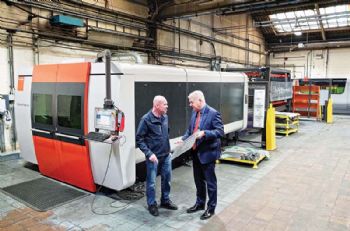
Holmfirth-based sheet metal design and engineering specialist Allsops Ltd has progressed from CO
2 to fibre laser cutting, resulting in significant financial savings for the company.
Mild steel from 1.2 to 3mm thick is mainly processed; and for these gauges (and even material up to 6mm thick), the production output from each of two Bystronic fibre laser machines (from Coventry-based Bystronic UK Ltd —
www.bystronic.com) is at least three-times that of the CO
2 models they replaced — and the running costs are much lower.
Furthermore, the sub-contractor upgraded its bending capability during 2018 with the addition of two Xpert 40 Bystronic press brakes, which have a bending length of 1m and a stroke of 200mm. T
hese raise the number of press brakes on site from this supplier (and predecessor companies) to 11; they are also more efficient than 3m machines when bending small parts, as the latter have slower axis movements.
Further benefits come from Allsops’ use of the Bystronic’s BySoft 7 software to program both the fibre laser cutting machines and the new press brakes.
It results in the seamless and rapid progression from cutting a blank to bending — and guarantees the accuracy of the first-off part.
Allsops’ technical director Stephane Lericolais says this is invaluable for economy of production when dealing with prototypes and short runs, adding that the software includes simulation of the bending sequence to identify any impending collisions.
“We previously used generic programming software for laser cutting and bending, but we have standardised on BySoft 7 since 2010.
“It imports our customers’ 3-D CAD models, flattens them and automatically generates programs offline for cutting the parts, nesting them optimally within a 3 x 1.5m sheet, and then bending them accurately.
"We know that the first part will be within tolerance; previously, before producing a prototype or starting a batch run, we would have to cut a blank, calculate the bend allowance, fold the part, check it for accuracy and have to do the same again perhaps once or twice before the job was right.
"All of this created scrap and was time-consuming. Now, production can start more quickly, and the compact Xpert 40 press brakes are also highly efficient.”
Allsops has been a customer of Bystronic or its acquired companies for more than 20 years, and there is little sheet metal-processing equipment on the Holmfirth site that has not been sourced from this supplier (apart from a bending line and a punch press); and while thinner gauges of mild steel constitute most of the material going through the machines, plate up to 25mm thick is also cut, as well as stainless steel and aluminium up to 30mm.
Fibre benefits
The sub-contractor was an early adopter of CO
2 laser cutting, installing its first model back in 1995. Latterly, there were two such machines on the shopfloor, with a 4.4kW and a 5.2kW laser source.
They were replaced in 2015 and 2016 by a BySprint Fiber and a ByStar Fiber, both with a 6kW laser and a 3 x 1.5m sheet capacity.
These machines are supplied with material from ByTrans handling units that were formerly fitted to the CO
2 machines, enabling the automated delivery of fresh sheets to the machines and the return of laser-profiled components for removal from their skeleton.
Allsops is yet another good example of where cutting with a fibre laser has massively increased productivity compared with CO
2 — in this case, typically threefold.
Managing director Rob Machon and his team had been keeping an eye on the advent of the technology and had watched the introduction of machines with 2, 3 and then 4kW of fibre laser power, but they decided to wait until 6kW became available before making their first fibre investment.
The BySprint model proved to be a revelation in terms of increased throughput, but the ByStar installed the following year raised performance much further, thanks to faster axis movements and ‘higher dynamics’ compared with the earlier fibre machine.
Some sheets are processed 30% faster if the components are complex, while there is still an improvement of nearly 10% for the simplest jobs.
Together, these two machines are so productive that to achieve Allsops’ required throughput, it is no longer necessary for the company to run the factory 24/7; this has led to significant labour cost savings. Currently, a night shift is needed just four days per week, with weekend working no longer necessary.
At the end of Friday afternoon, the two ByTrans are loaded with material, which provides both machines with a couple of hours’ ‘lights out’ running.
Mr Lericolais says that further savings are derived from the fact that there is no longer a need for any laser gas or beam purging gas, and that assist gas usage per cut component is 37% less.
Additionally, electricity bills have been reduced by a similar amount, as CO
2 technology requires 98kW of input power to generate 6kW of laser power at the cutting nozzle.